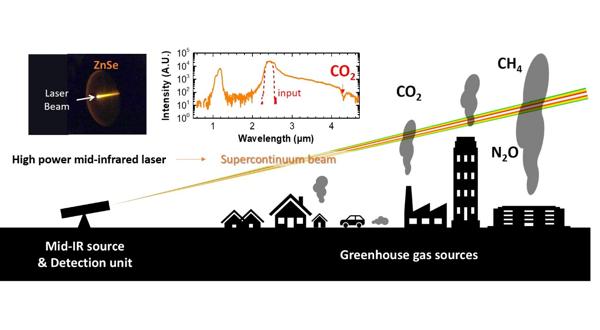The mid-infrared wavelength ranges from 2 to 15 μm is of great interest for many interesting applications such as remote sensing and free-space optical communications, but this spectral range has not been fully explored due to the lack of laser sources. In particular, the 3-8 μm range is called of the "molecular fingerprint" region because of the abundant absorption lines from almost most chemicals. These molecular fingerprints are very useful for chemical sensing in combination with broadband or tunable mid-infrared laser beams.
Diffraction is part of the nature of light. Even well-collimated laser beams start being strongly diffracted after a certain length of propagation, increasing the beam size and reducing the beam intensity significantly. To elongate the length of laser beam propagation with minimal diffraction, we have to use a large beam diameter, which also reduces the intensity of the beam and requires large optics. One of the interesting methods of avoiding the diffraction is to produce a "laser filament" which is formed when the nonlinear self-focusing of a high-power laser beam is balanced by the diffraction and defocusing from laser-produced plasmas in a solid or gas. The laser filamentation in the mid-infrared fingerprint region can be particularly useful for remote sensing if laser filaments can be formed in the ambient air.
So far mid-infrared laser filamentation has been investigated using ultrafast mid-infrared light sources based on nonlinear wavelength conversion from near-infrared lasers. However, the recent advances of mid-infrared solid-state laser technology enable to generate ultrafast high-power laser beams in the wavelength range from 1.9 to 4.5 μm. Motivated by the availability of such laser sources, in the latest report at High-Power Laser Science and Engineering Vol. 9, 2021 (Sang-Hoon Nam, Garima C. Nagar, Dennis Dempsey, et al. Multi-octave-spanning supercontinuum generation through high-energy laser filaments in YAG and ZnSe pumped by a 2.4 μm femtosecond Cr:ZnSe laser[J]. High Power Laser Science and Engineering, 2021, 9(2): 02000e12), Dr. Sang-Hoon Nam and his coworkers at Massachusetts Institute of Technology (MIT) and Binghamton University, USA, demonstrated the generation of high-power ultrabroadband mid-infrared laser filaments directly pumped by a mid-infrared solid-state laser, for the first time.
They used a high-power Cr:ZnSe laser system operating at 2.4 μm of center wavelength and generating 250 fs (fs = 10-15 s) pulses to generate a single filament in a solid, such as YAG and ZnSe medium. They demonstrated the extreme spectral broadening, called "supercontinuum generation", to cover the wavelength from the visible to 5 μm range, which spans more than two octaves of spectral band. The input pulse energy of 100 μJ in the single filament is reportedly the highest among any laser filamentation demonstrated in a solid. This phenomenon was also numerically studied using comprehensive 3-dimensional simulations performed by Prof. Bonggu Shim's group at Binghamton University. Their simulations showed a good agreement with the experimental observations and explains other interesting dynamics such as self-compression and harmonic generation.
Dr. Kyung-Han Hong from MIT, who has led this research, believes that although it is still in the early stage, the research of mid-infrared laser filamentation will find numerous applications not only in remote sensing, such as environmental monitoring and remote detection of hazardous chemicals, but also fundamental laser-matter interactions in the strong-field regime, such as attosecond pulse generation and high-power laser beam delivery in the form of "light bullet". He also emphasizes that the use of compact and robust mid-infrared solid-state lasers will accelerate this research towards the practical applications of laser filaments to solve real-world problems. Dr. Hong and Shim's groups plan to continue their collaboration to develop a prototype remote sensing system in the near future.

The conceptual drawing of environmental monitoring based on ultrabroadband mid-infrared laser filamentation. The experimental laser filament in ZnSe is visually shown at the upper left picture. The CO2 absorption line at 4.3 μm is clearly observed in the measured spectrum from this laser filament (upper middle).


